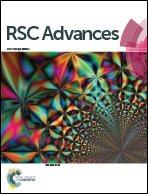Structural and electronic properties of KY(BH4)4: DFT+U study†
Abstract
The structure, composition, and electronic property of mixed-cation borohydrides are of significant importance for understanding and improving their thermodynamic and kinetic activities. Conventional density functional theory (DFT) fails to correctly describe the electronic structure of the system due to insufficient cancellation of the self-interaction energy and underestimation of the band gap. In the present work, we present a systematic investigation of the structural and electronic properties of KY(BH4)4 for the first time at the DFT+U level of theory. It is found that the LDA+U method underestimates the lattice volume by ∼17.36%, while the PBE+U and PW91+U methods show good agreement with the experimental value at U = 3 and U = 4, respectively. The total energy of KY(BH4)4 calculated by PW91+U method at U = 4 is 0.97 eV lower than that calculated by PBE+U method at U = 3. We suppose that the PW91+U method is more suitable for the structural and electronic properties study of KY(BH4)4 due to the lower total energy. K+ connects with BH4− complex through electrostatic attraction, while weak covalent interaction exists between Y3+ and BH4− complex.



 Please wait while we load your content...
Please wait while we load your content...